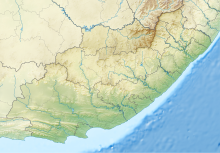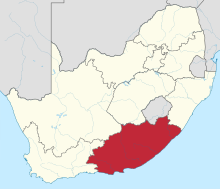Port Elizabeth Airport
| Port Elizabeth International Airport | |||||||||||||||
|---|---|---|---|---|---|---|---|---|---|---|---|---|---|---|---|
| Summary | |||||||||||||||
| Airport type | Public | ||||||||||||||
| Owner/Operator | Airports Company South Africa | ||||||||||||||
| Serves | Port Elizabeth, Eastern Cape, South Africa | ||||||||||||||
| Elevation AMSL | 226 ft / 68 m | ||||||||||||||
| Coordinates | 33°59′05″S 025°36′37″E / 33.98472°S 25.61028°ECoordinates: 33°59′05″S 025°36′37″E / 33.98472°S 25.61028°E | ||||||||||||||
| Website | http://www.airports.co.za/airports/port-elizabeth | ||||||||||||||
| Map | |||||||||||||||
| Location of airport in Eastern Cape province | |||||||||||||||
| Runways | |||||||||||||||
|
|||||||||||||||
Port Elizabeth International Airport (IATA: PLZ, ICAO: FAPE) is an airport serving Port Elizabeth, a city in the Eastern Cape province in South Africa. It was formerly known as H. F. Verwoerd Airport. The airport is owned and operated by the Airports Company South Africa which also operates nine other airports around South Africa.
The airport is located approximately two miles south of the city's central business district. This has earned it the name "Ten minute airport" because it is said to be less than ten minutes' drive from most major areas of the city.
In 2016, the airport served 1,582,889 passengers.
A number of hotels are present on or near the airport. Ground transportation is provided by local taxis. The airport also has a selection of parking areas and several car rental offices, Such as Eurocar, Bidvest and a few more
A highlight in Port Elizabeth's history was the first flight to Port Elizabeth from Cape Town in 1917, made by Major Allister Mackintosh Miller. At that time, this was considered a long distance flight, and it heralded the start of the civil aviation industry in Port Elizabeth. This flight and many more has been captured on canvas by Ron Belling and is on display at the Ron Belling Art Gallery.
Port Elizabeth Airport was established in 1929 in close proximity to the city. It was initially founded by Lieutenant Colonel Miller, who needed an airfield to operate his postal service between the city and Cape Town. It was only officially opened some nine years later, in 1936, boasting a single runway, one hangar and a concrete apron. However, the foundations of this infrastructure will be removed to make room for additional vehicle parking.
During World War II, the airfield was extended to accommodate 42 Air School for the Royal Air Force and 6 Squadron South African Air Force on the southern and eastern sides of the field. Commercial operations were conducted from the northern side. In 1954, it saw the landing of the first jet-propelled aircraft - five De Havilland Vampire FB9s.
Construction of the permanent terminal buildings, runways and an air traffic control building began in 1950. The commercial operation was moved to an airfield at St Albans, some 25 km from the city centre, for the construction period. The new buildings were officially opened in 1955. In 1973 the apron was extended to accommodate larger aircraft and a new departures terminal was opened in 1980. The facilities served the airport community until 2000 when plans for a major terminal upgrade were drawn.
...
Wikipedia


